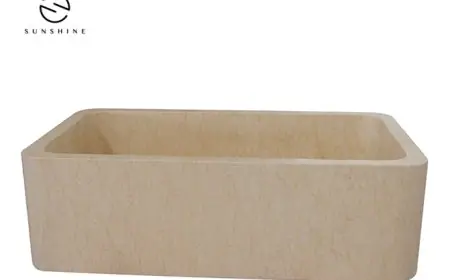Marble Floor Polishing: Restoring Elegance, One Shine at a Time
Discover the art of marble floor polishing to revive the brilliance of your home's marble flooring. Learn expert tips and techniques for marble floor care.

If you're fortunate enough to have a marble floor in your home, you're likely well aware of how stunning it can look when it's in prime condition - glossy, smooth, and reflecting light in that unique way only marble can. However, maintaining that sheen can be a challenge, whether you're dealing with a floor that has dulled over time or are simply eager to sustain its existing luster. The good news is that achieving that coveted glossy finish isn't as daunting as it may seem; with the right approach and good marble wax polish, you can keep your marble restoration as splendid as the day it was installed.
The truly encouraging aspect of marble floor maintenance is that it's entirely possible to tackle this task yourself, without the need to hire professionals. All that's required are a few specialty products designed specifically for marble care, and a little bit of your time. From cleansers to sealants, there are various items on the market that can help restore or preserve your marble's shine. Whether you're looking to revive a floor that has lost its luster or is proactively seeking to extend the lifespan and beauty of your investment, a simple guide and a few key products can go a long way in keeping your marble floor in mint condition.
How to Polish Marble Floors
Step One: Deep Clean
Before you begin the process of revitalizing your marble floor, it's crucial to deep clean the surface. This goes beyond just dusting or cleaning up occasional spills. A thorough cleansing is essential for achieving a gleaming finish.
- Initially, use a soft, dry cloth to remove any loose crumbs or dirt from the surface. Follow this by moistening the floor with a damp sponge.
- Then, opt for either a specialized marble cleaning product or add a few drops of gentle dish soap to your damp cloth for cleaning.
- Spread your selected cleaner evenly over the entire floor, focusing on buffing out any stains or debris.
Step Two: Remove Stains
For more persistent stains, you have the option of using a commercial stain remover specifically designed for marble, also known as a poultice, or crafting your own.
Here's how to make a DIY poultice for stain removal:
- Combine one tablespoon of ammonia with half a cup of hydrogen peroxide.
- Gradually add baking soda to the liquid mixture until it achieves a thick, paste-like consistency, similar to that of peanut butter or sour cream.
- Using a clean paintbrush, apply the poultice onto the areas where the stain is present.
- Layer the poultice to a thickness of about a quarter to half an inch, extending it at least an inch beyond the stain's perimeter.
- Cover the applied poultice with plastic wrap, securing the edges with masking tape.
- Allow the poultice to sit and harden for 12 to 24 hours.
- Once the poultice is fully dry, remove the plastic wrap. Carefully scrape off the dried poultice using a razor blade or a spatula. If needed, you can moisten the poultice with half a cup of water to facilitate easier removal. Be cautious not to damage the marble surface while scraping.
- By following these steps, you can effectively remove stubborn stains from your marble floor.
Step Three: Polish
While deep etching on marble surfaces usually demands professional intervention, light etching can often be treated with a specialized marble floor polishing powder available at home improvement stores.
- Start by dampening a clean cloth with water and then wiping the etched sections.
- Lightly scatter some marble polishing powder over the areas with etching and carefully buff them as directed by the product’s guidelines.
- Finally, use a clean, wet cloth to wipe away any remaining residue, and then dry the marble surface to unveil its freshly revived luster.
Step Four: Seal
An ounce of prevention is worth a pound of cure. To maintain your marble floor's natural beauty and prevent significant staining, it's recommended to apply a sealer at least twice a year. For the most effective results, consult your manufacturer for guidance on suitable products and methods tailored for your specific marble.
- Once you've acquired the right marble sealer, either spray or pour it directly onto the surface of the marble.
- Use a clean, dry cloth to distribute the sealer evenly over the entire floor. Allow it to penetrate the stone for the duration indicated on the product's packaging, which is generally five minutes or less.
- After the specified time has elapsed, use another clean, dry cloth to buff the sealer into the marble in a circular motion.
- Continue buffing until the sealer is fully absorbed and the marble feels dry to the touch.
- You'll know the process is complete when the marble surface is smooth and free from any sticky or tacky residue.
How to Maintain Your Marble Floor’s Shine
- Regular Dry Cleaning - To maintain your marble floor's shine over an extended period, it's advisable to dry clean it consistently using a dust mop or a soft cloth. If you're living alone, a weekly sweep is generally enough. However, in larger households with four or more people, daily dusting is likely necessary to prevent the accumulation of dust, which can lead to minor scratches if neglected.
- Immediate Spill Cleanup - Marble is a porous material, making it susceptible to absorbing liquids. Should a spill occur, act quickly to clean it up. This prevents the liquid from seeping into the marble's pores and causing a challenging stain. Prompt action is essential to keep your marble looking its best.
- Blot, Don't Scrub - When tackling stains, it's crucial to blot rather than scrub the affected area. Rinse the spill thoroughly with water to balance the pH levels, minimizing the risk of staining or etching. This is particularly vital for acidic substances like citrus, tomato, vinegar, and coffee.
- Think About Carpets and Rugs - In areas of your home that see a lot of foot traffic, consider adding carpets or rugs to your flooring. These not only enhance the aesthetic appeal of your space but also serve as protective barriers against dirt, sand, and other materials that can be abrasive to your marble floor.
What's Your Reaction?

























































































